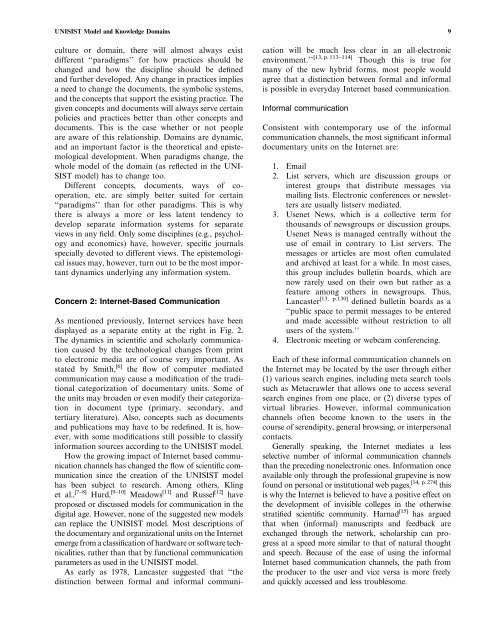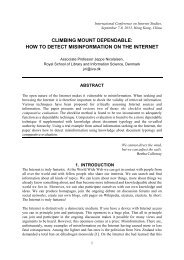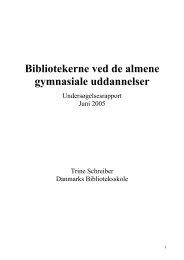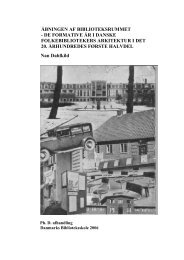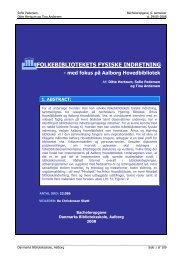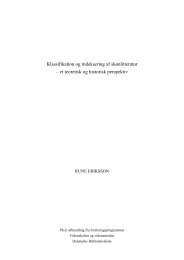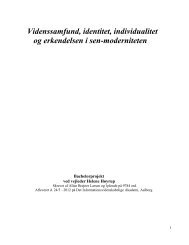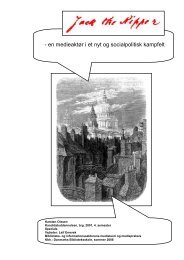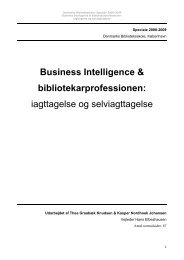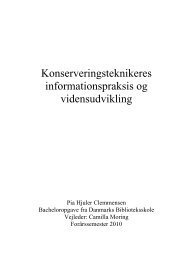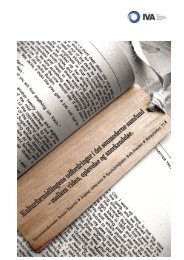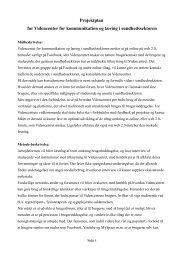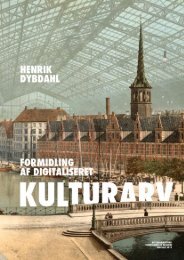UNISIST Model and Knowledge Domains
UNISIST Model and Knowledge Domains
UNISIST Model and Knowledge Domains
You also want an ePaper? Increase the reach of your titles
YUMPU automatically turns print PDFs into web optimized ePapers that Google loves.
<strong>UNISIST</strong> <strong>Model</strong> <strong>and</strong> <strong>Knowledge</strong> <strong>Domains</strong> 9<br />
culture or domain, there will almost always exist<br />
different ‘‘paradigms’’ for how practices should be<br />
changed <strong>and</strong> how the discipline should be defined<br />
<strong>and</strong> further developed. Any change in practices implies<br />
a need to change the documents, the symbolic systems,<br />
<strong>and</strong> the concepts that support the existing practice. The<br />
given concepts <strong>and</strong> documents will always serve certain<br />
policies <strong>and</strong> practices better than other concepts <strong>and</strong><br />
documents. This is the case whether or not people<br />
are aware of this relationship. <strong>Domains</strong> are dynamic,<br />
<strong>and</strong> an important factor is the theoretical <strong>and</strong> epistemological<br />
development. When paradigms change, the<br />
whole model of the domain (as reflected in the UNI-<br />
SIST model) has to change too.<br />
Different concepts, documents, ways of cooperation,<br />
etc. are simply better suited for certain<br />
‘‘paradigms’’ than for other paradigms. This is why<br />
there is always a more or less latent tendency to<br />
develop separate information systems for separate<br />
views in any field. Only some disciplines (e.g., psychology<br />
<strong>and</strong> economics) have, however, specific journals<br />
specially devoted to different views. The epistemological<br />
issues may, however, turn out to be the most important<br />
dynamics underlying any information system.<br />
Concern 2: Internet-Based Communication<br />
As mentioned previously, Internet services have been<br />
displayed as a separate entity at the right in Fig. 2.<br />
The dynamics in scientific <strong>and</strong> scholarly communication<br />
caused by the technological changes from print<br />
to electronic media are of course very important. As<br />
stated by Smith, [6] the flow of computer mediated<br />
communication may cause a modification of the traditional<br />
categorization of documentary units. Some of<br />
the units may broaden or even modify their categorization<br />
in document type (primary, secondary, <strong>and</strong><br />
tertiary literature). Also, concepts such as documents<br />
<strong>and</strong> publications may have to be redefined. It is, however,<br />
with some modifications still possible to classify<br />
information sources according to the <strong>UNISIST</strong> model.<br />
How the growing impact of Internet based communication<br />
channels has changed the flow of scientific communication<br />
since the creation of the <strong>UNISIST</strong> model<br />
has been subject to research. Among others, Kling<br />
et al., [7–8] Hurd, [9–10] Meadows [11] <strong>and</strong> Russel [12] have<br />
proposed or discussed models for communication in the<br />
digital age. However, none of the suggested new models<br />
can replace the <strong>UNISIST</strong> model. Most descriptions of<br />
the documentary <strong>and</strong> organizational units on the Internet<br />
emerge from a classification of hardware or software technicalities,<br />
rather than that by functional communication<br />
parameters as used in the <strong>UNISIST</strong> model.<br />
As early as 1978, Lancaster suggested that ‘‘the<br />
distinction between formal <strong>and</strong> informal communi-<br />
cation will be much less clear in an all-electronic<br />
environment.’’ [13, p. 113–114] Though this is true for<br />
many of the new hybrid forms, most people would<br />
agree that a distinction between formal <strong>and</strong> informal<br />
is possible in everyday Internet based communication.<br />
Informal communication<br />
Consistent with contemporary use of the informal<br />
communication channels, the most significant informal<br />
documentary units on the Internet are:<br />
1. Email<br />
2. List servers, which are discussion groups or<br />
interest groups that distribute messages via<br />
mailing lists. Electronic conferences or newsletters<br />
are usually listserv mediated.<br />
3. Usenet News, which is a collective term for<br />
thous<strong>and</strong>s of newsgroups or discussion groups.<br />
Usenet News is managed centrally without the<br />
use of email in contrary to List servers. The<br />
messages or articles are most often cumulated<br />
<strong>and</strong> archived at least for a while. In most cases,<br />
this group includes bulletin boards, which are<br />
now rarely used on their own but rather as a<br />
feature among others in newsgroups. Thus,<br />
Lancaster [13, p.130] defined bulletin boards as a<br />
‘‘public space to permit messages to be entered<br />
<strong>and</strong> made accessible without restriction to all<br />
users of the system.’’<br />
4. Electronic meeting or webcam conferencing.<br />
Each of these informal communication channels on<br />
the Internet may be located by the user through either<br />
(1) various search engines, including meta search tools<br />
such as Metacrawler that allows one to access several<br />
search engines from one place, or (2) diverse types of<br />
virtual libraries. However, informal communication<br />
channels often become known to the users in the<br />
course of serendipity, general browsing, or interpersonal<br />
contacts.<br />
Generally speaking, the Internet mediates a less<br />
selective number of informal communication channels<br />
than the preceding nonelectronic ones. Information once<br />
available only through the professional grapevine is now<br />
found on personal or institutional web pages, [14, p. 274] this<br />
is why the Internet is believed to have a positive effect on<br />
the development of invisible colleges in the otherwise<br />
stratified scientific community. Harnad [15] has argued<br />
that when (informal) manuscripts <strong>and</strong> feedback are<br />
exchanged through the network, scholarship can progress<br />
at a speed more similar to that of natural thought<br />
<strong>and</strong> speech. Because of the ease of using the informal<br />
Internet based communication channels, the path from<br />
the producer to the user <strong>and</strong> vice versa is more freely<br />
<strong>and</strong> quickly accessed <strong>and</strong> less troublesome.


